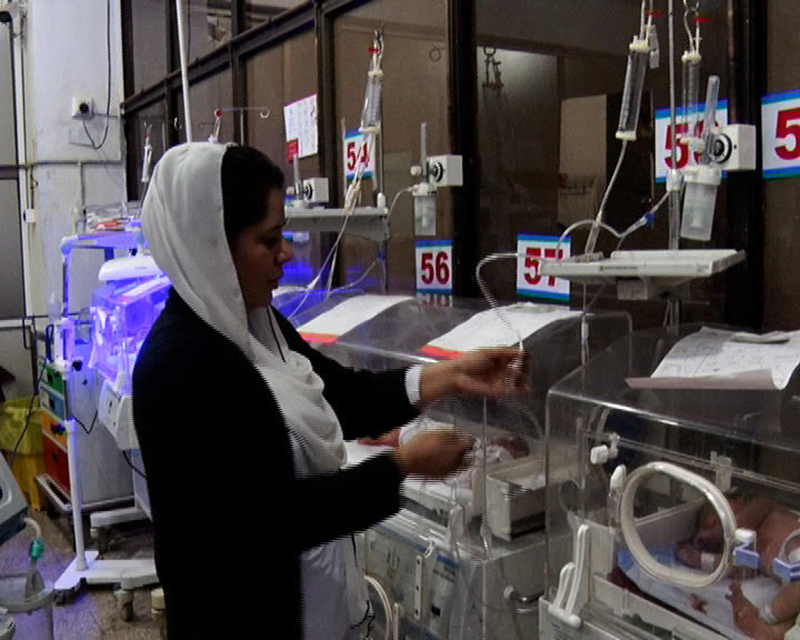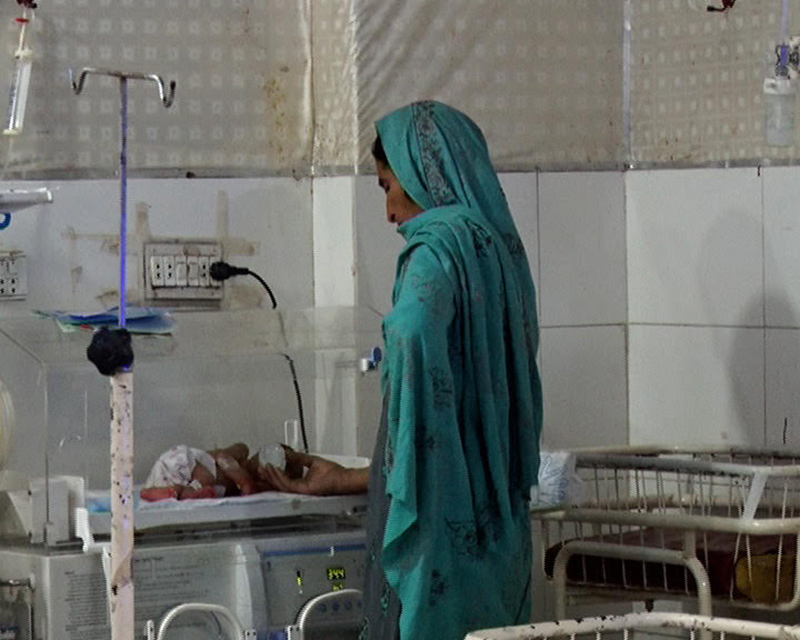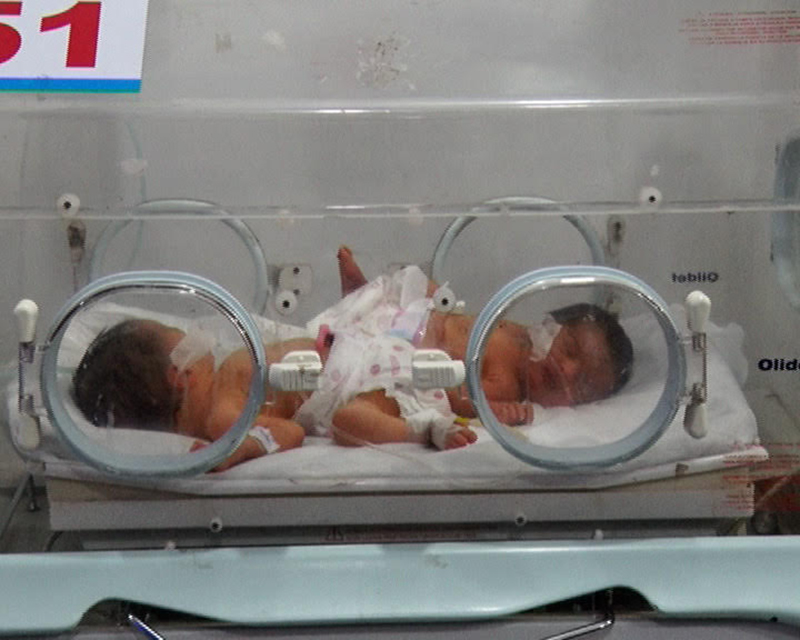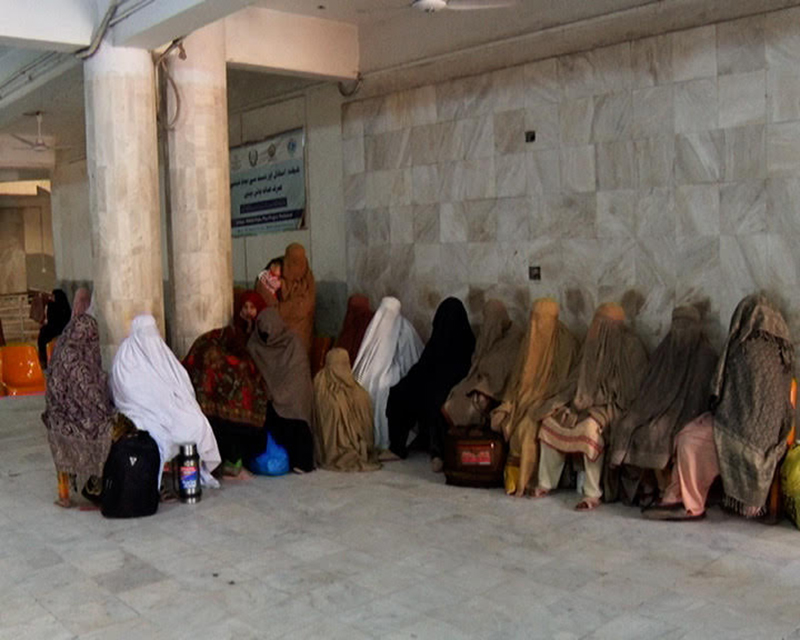Maternal Mortality: Ticking up in Pakistan while India stems rise
Despite gains, maternal deaths haunt South Asia. While the figure ticks up in Pakistan, in India the rise has been stemmed amid challenges, report Amer Malik and Abantika Ghosh from across the border
For centuries in South Asia, childbirth has sometimes brought tragedy instead of joy. India’s Taj Mahal is a visible reminder of the lasting plague of maternal mortality – built in memory of Mumtaz Mahal, a Mughal emperor’s wife who died in 1631, shortly after giving birth to their 14th child.
But in recent decades, both India and Pakistan made great strides reducing the numbers of women who die bringing new life into the world.
And that progress continues in India – even as Pakistan’s maternal mortality rate ticks up for the first time in years.
Meanwhile, governments, non-governmental organizations and community groups are doing what they can to keep more mothers alive in both countries.
A troubling rise in Pakistan
Until recently, maternal deaths in Pakistan had been dropping steadily and sharply, falling from 286 deaths per 100,000 live births in 2000 to 140 per 100,000 in 2017, estimates by various international agencies including World Health Organization suggest. But the most recent consolidated number from the Pakistan Maternal Mortality Survey showed rates had risen since then, to 186 per 100,000 in 2019.
Although it’s still lower than the overall rate from 13 years earlier, the rise is extremely troubling to experts. With a new survey due out in the next few months, they predict the rates will only continue to rise in the wake of a series of disasters, beginning with the COVID-19 pandemic.
“There were large-scale disruptions in the healthcare delivery system at the height of the pandemic, thus severely affecting perinatal care to the pregnant women. Things can only aggravate from there,” said Dr. Shamsa Humayun, vice president of the Society of Obstetricians and Gynaecologists of Pakistan and pro-vice chancellor of Fatima Jinnah Medical University in Lahore.
 A nurse inquires about the health of a child lying in an incubator at Lady Reading Hospital in Peshawar, Pakistan. Photo by Wisal Yousafzai.
A nurse inquires about the health of a child lying in an incubator at Lady Reading Hospital in Peshawar, Pakistan. Photo by Wisal Yousafzai.
A nurse inquires about the health of a child lying in an incubator at Lady Reading Hospital in Peshawar, Pakistan. Photo by Wisal Yousafzai.
As COVID infections waned, the country was wracked by seasonal dengue epidemics, then devastating floods that deluged one-third of the country’s territory.
“The risk of transmission of water- and vector-borne diseases, compounded by inaccessibility to maternal healthcare services during floods, has potentially wreaked havoc,” she said.
But disease and flooding aren’t the only culprits behind rising maternal deaths. Population Council Pakistan – a non-governmental organization focusing on population growth, family planning and reproductive health – linked Pakistan’s annual growth rate of 2.4% directly with the maternal mortality rate, which translates to 11,000 maternal deaths annually.
 A grandmother stands at an incubator looking at her grandson lying in an incubator, looking worried about the health of the baby at Lady Reading Hospital in Peshawar, Pakistan. Photo by Wisal Yousafzai.
A grandmother stands at an incubator looking at her grandson lying in an incubator, looking worried about the health of the baby at Lady Reading Hospital in Peshawar, Pakistan. Photo by Wisal Yousafzai.
A grandmother stands at an incubator looking at her grandson lying in an incubator, looking worried about the health of the baby at Lady Reading Hospital in Peshawar, Pakistan. Photo by Wisal Yousafzai.
“Approximately 3,800 mothers can be saved each year simply by fulfilling the unmet need of increasing contraceptive use from the current 34% to 52%,” said Samia Ali Shah, the council’s project director.
She said Pakistan’s total fertility rate of 3.6 children per woman is the highest among the countries in South Asia, and the country is now the 5th most populous in the world. Because of the unmet need for family planning, each couple of childbearing age has an average of one unintended child.
Certain areas in Pakistan fare worse than others when it comes to maternal mortality. For example, Balochistan province has the highest rate, at 298 deaths per 100,000 live births, compared with 157 in Punjab, which has the nation’s lowest rate. And rural areas generally do worse than urban areas. Among moms who die, obstetric hemorrhage is the most common cause, followed by hypertensive, or blood pressure, disorders.
Throughout the country, a lack of funds – both on an individual and societal level – exacerbates the problem. According to a report by the Punjab Economic Research Institute, Pakistan spends less than 1% of its gross domestic product on healthcare and has low levels of public health spending and per-person health spending compared with other countries in the region. Families face high out-of-pocket costs that make quality maternal health services inaccessible for many expecting mothers.
The location of health services also makes a difference. About a fourth of the primary care facilities in the province of Punjab are located at a distance of more than 10 kilometers from most villages and burden the households in terms of cost and time. Experts and surveys show that maternal health services are used more often by mothers who are affluent, educated and urban than those who are poor, uneducated and rural.
Similar problems in India, but no recent rise
As in Pakistan, maternal deaths in India also fell steeply for decades – from 398 per 100,000 live births in 1997-98 to 97 per 100,000 in 2018-20. And that’s despite many of the same challenges Pakistan faces: a lack of healthcare access in rural areas, malnutrition and difficult geography in a country that sees more than 25 millions births a year.
India’s latest maternal death rate is lower than in neighboring Pakistan and shows no sign of ticking back up.
Experts say that’s because of a continued focus on the problem, and a boots-on-the-ground strategy to help women get the care they need.
“We took a three-pronged strategy on MMR. First was to improve institutional deliveries and (standard operating procedures), increase the frequency of visits by ASHAs (Accredited Social Health Activists, a group of grassroots healthcare workers who go door to door offering health services) and also attend to those women who were not going to hospitals for deliveries. The basic issue was of improving standards both at the level of the caregiver and in the delivery rooms at the center. We devised the incentive system of ASHAs in such a way that they got good money only if they visited throughout the nine months,” said former health secretary C K Mishra, who was among those who oversaw this dramatic progress.
A campaign by ASHAs, in which they went door to door doing some basic blood tests on pregnant women and referring them to higher level care when required, also generated confidence among women, he said. In addition, there were anganwadi centers – local centers set up under a government programme to reduce childhood malnutrition – that provided free meals to pregnant and lactating mothers. This was done under the National Food Security Act 2013.
“States also upped their game,” Mishra said.
Across the country of 1.4 billion, more pregnant women received care from health professionals. According to the latest National Family Health Survey, a government assessment conducted every few years, 78% of new mothers received postnatal care from a doctor, nurse or other healthcare professional within two days of delivery. And the number of births in hospitals rose from 79% in 2015-16 to 89% from 2019-21.
Solutions: Reaching the Unreached
Both countries have realized a key to reducing maternal mortality is reaching out to the most vulnerable moms.
India’s recent successes in family health have a lot to do with a landmark reform in 2005, when the National Rural Health Mission was started and healthcare workers went door-to-door in communities to provide basic healthcare at their doorsteps. Various incentive schemes under the mission ensured that more women were financially able to go to the hospital for deliveries.
States modified schemes under the mission’s umbrella to fit local needs, according to a 2010 article in the Indian Journal of Public Health by the chief UNICEF officer in Chennai. For example, more developed states in South India modified a conditional cash transfer scheme designed to motivate women to give birth in the hospital. To target those at greatest risk and allow the money to go further, they limited it to women below the poverty line up to the first two births. A few states with particularly high maternal death rates, meanwhile, allowed all women to partake in the scheme.
 Two babies lie in an incubator in the Lady Reading Hospital in Peshawar, Pakistan. Photo by Wisal Yousafzai.
Two babies lie in an incubator in the Lady Reading Hospital in Peshawar, Pakistan. Photo by Wisal Yousafzai.
Two babies lie in an incubator in the Lady Reading Hospital in Peshawar, Pakistan. Photo by Wisal Yousafzai.
Another program that helped reduce maternal deaths in India, experts said, is the Janani Shishu Suraksha Karyakram, which entitles all pregnant women delivering in public health institutions to free delivery, including Cesarean sections. They also get free medicines, diagnostics, blood and transportation between their homes and health care facilities.
India’s federal Mother and Child Tracking system monitors pregnancies and immunizations for mothers and newborns, generating work plans daily for the women health workers on the ground.
Meanwhile, provincial governments in Pakistan are also trying to do more outreach and offer services to women in local communities.
Dr. Khizer Hayat Khan, director of maternal child health for Khyber Pakhtunkhwa province, said the government has employed 16,500 Lady Health Workers, who are going door-to-door to raise awareness of maternal health issues. In addition to multiple other government projects, he said community midwives are also spreading the message of family planning.
Khan stressed that pregnant women should make sure they have four antenatal visits before giving birth to prevent pregnancy complications. But currently, he said, many families face what he called the “3 Ds” – delay in reaching care, delay in seeking care and delay in receiving care.
Since the floods, he said the health department has provided medicines and more health workers in certain affected areas.
On a national basis in Pakistan, experts said, the problem will be extremely difficult to tackle. Pakistan’s latest maternal mortality survey showed a staggering 12% of all deaths of younger women nationally are due to pregnancy and childbirth complications, which is also the single biggest cause of deaths among young women.
“This isn’t a result of any fatal disease but just a phase in a woman’s life (when she is) otherwise very healthy. This only goes on to show that we, as a society, did not value our women,” observes Dr. Azra Ahsan, the eminent gynaecologist and public health expert, who currently serves as technical consultant and vice president of the National Committee for Maternal and Neonatal Health.
She said the system does not have the capacity to stem the number of deaths among women of child-bearing age – systemic cultural barriers at the societal level, and a lack of commitment and professionalism at institutional levels contribute to this otherwise preventable disaster.
She said Pakistan did not make progress commensurate with the amount of global funds poured into the nation’s mother and child health sector in the last two decades.
“The WHO, UNICEF, UNFPA Bill and Melinda Gates Foundation among other global institutions invested a lot of money, scores of local NGOs are providing community service, yet desired results remain elusive,” she said.
In spite of similar trends of uneven reduction in maternal mortality across different provinces and the urban and rural areas in both countries, India hopes to achieve its target of MMR of 70 per 100,000 live births by 2030. “But, I don’t see that happening in Pakistan,” Ahsan said.
One tragedy among many: Young Pakistani mom dies giving birth
By Wisal Yousafzai
PESHAWAR – When an ultrasound showed that Lubna Khan was having a little boy, she began shopping for baby things and making tiny clothes. Her husband Zarif couldn’t wait to welcome their new son.
But hope turned to tragedy months later, when 25-year-old Lubna bled to death during childbirth and lost the baby, too.
In early October, Zarif found himself mourning beside her coffin. His wife of 10 years also left two daughters and two sons.
The Khans, who live in Khyber Pakhtunkhwa province, endured a tragedy that happens all too often in the region – a reality social workers and nongovernmental organizations are struggling to change. For decades, Pakistan’s maternal mortality rate was on the decline, but recently began ticking up.
According to Pakistan’s latest maternal mortality survey, from 2019, 186 women died for every 100,000 live births in 2019 – about 11,000 maternal deaths each year in a country with the highest fertility rate in South Asia.
About 1,900 of those deaths occur in the northwestern province of KP, where the Khans live and where the fertility rate is even higher than the national average.
Advocates say many women lack proper treatment during pregnancy and can’t get to hospitals quickly enough when things go wrong. In KP’s urban areas, doctors and hospitals are generally available. But most rural areas don’t have enough doctors and health facilities.
When Lubna Khan was feeling unwell, she told her husband to take her to the doctor. Instead, he took her to a “lady health worker” close to their house, who he said was neither well-trained nor had necessary medical devices. Lubna was a lady health worker herself, helping vaccinate children in her village for polio.
Her brother Nizam Khan said they shifted Lubna to a nearby healthcare center that lacked qualified doctors, and her condition deteriorated. At one point, Nizam Khan said, doctors decided she needed a C-section, and when things took a dangerous turn, they told the family to get her to another hospital.
It took more than four hours to get there. By the time they arrived, the doctors told them that it was too late. Her brother Nizam, who was with her as her case deteriorated, said no one could stop her bleeding.
“We not only lost our sister, but also our nephew,” Nizam Khan said.
 Women wait for checkups from a doctor at Lady Reading Hospital in Peshawar, Pakistan. Photo by Wisal Yousafzai.
Women wait for checkups from a doctor at Lady Reading Hospital in Peshawar, Pakistan. Photo by Wisal Yousafzai.
Women wait for checkups from a doctor at Lady Reading Hospital in Peshawar, Pakistan. Photo by Wisal Yousafzai.
Experts say lack of access to care is just one of several things pushing up maternal mortality. Another problem is that women – including Lubna Khan – marry and begin having children in their teens, when they are likely to face more health problems during pregnancy and birth.
Sana Ahmad, a social worker who supports women’s rights, said it’s concerning that in Khyber Pakhtunkhwa, girls are married at the age of 14 or 15. At those young ages, she said, a girl should be getting an education.
With a rising population and more families struggling with low incomes, she said most parents want to marry off their daughters as soon as possible.
She urged the government and civil society to come forward and discourage early child marriages. She said the government should also provide health care units for women in remote areas.
But even if such improvements are put into place, they come too late for the Khan family. Lubna's brother said losing her was “disastrous.”
As he remembered her, tears rolled down his face.
(About the authors: Amer Malik is an investigative journalist associated with The News International, Pakistan. Abantika Ghosh is a journalist with ThePrint, India, and author of Billions Under Lockdown: The Inside Story of India’s Fight Against COVID-19. Wisal Yousafzai works for The Express Tribune and tweets at @WisalYousafzai. This report is part of a week-long cross-border reporting workshop held in Kathmandu, Nepal, organised by the US based East-West Center.)
IBNS
Senior Staff Reporter at Northeast Herald, covering news from Tripura and Northeast India.
Related Articles

Fit, cleared, gone: Why a 'normal' ECG didn’t save a 53-year-old neurosurgeon from a sudden heart attack
The sudden death of renowned Nagpur neurosurgeon Dr Chandrashekhar Pakhmode in the early hours of December 31 has sent shockwaves through the medical community and raised troubling questions about how heart attacks can strike even those who appear medically fit.

Kolkata’s air quality slips into ‘very poor’ zone as winter pollution peaks, data shows
Kolkata/IBNS: Kolkata’s air quality has deteriorated sharply this winter, with official monitoring data showing repeated episodes of “very poor” air quality across key parts of the city, even as the issue remains largely absent from political discourse ahead of the West Bengal Assembly elections.

Mumbai to Shanghai in real time: Kokilaben Hospital performs India’s first cross-border Robotic Surgeries!
Kokilaben Dhirubhai Ambani Hospital, Mumbai, has achieved a historic national milestone by successfully performing India’s first international remote robotic surgeries on two patients in Mumbai, with the operating surgeon located in Shanghai—over 5,000 kilometres away.

Village panic after funeral feast: 200 get rabies shots over ‘infected’ buffalo milk raita
Nearly 200 residents of a village in Uttar Pradesh were administered rabies vaccine shots after it emerged that raita—a curd-based Indian dish they had consumed—was prepared using milk from a buffalo that later died after being bitten by a dog.
Latest News

From currency crash to street bloodshed: What sparked Iran’s deadliest protests in three years

Bulgaria adopts euro, joining currency bloc despite public opposition

Cricketer summoned after using Palestinian flag during league match in Jammu and Kashmir

CM urges students to combine knowledge, technology, and spirituality

